My RAG123 marking experiment
My RAG123 experiment (with a huge nod to @ListerKev)
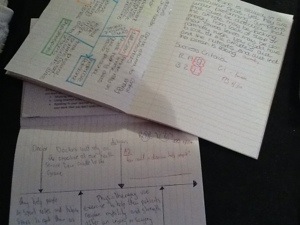
There are more educational blogs than there are grains of sand on all the beaches on Earth – Carl Sagan
I will start this blog with a bit of a confession. Marking books has never been something that I particularly enjoyed. Perhaps this isn’t that much of a confession because I’m sure that feeling is replicated by many teachers up and down the country. It took me a few years to really appreciate that the marking was for the benefit of the pupils rather than because of an upcoming book monitoring (or worse- an inspection). Since becoming a head of Department and then moving into SLT I have obviously emphasised the importance of regular marking to staff. However, even as recently as a years ago I was still having doubts about how effective my formative marking was. I would spend the time writing the comments and then I’d give the books back to pupils and I would see that my carefully crafted comments would have no impact. They almost seemed like a waste of time. My mantra for marking was to get it done promptly because late formative comments will not be valued by the pupils. This is certainly true but I was still struggling with the fact that my marking was not closing the gap between where the pupils were and where I wanted them to be.
Over the last 6 months I have read countless blogs on marking and feedback. Here are a selection of my personal favourites:
David Didau (@Learning Spy)- Marking is an act of love
Mary Myatt(@MaryMyatt)- Should I be marking every piece of work?
Alex Quigley(@HuntingEnglish)- Dirty Work
David Fawcett (@davidfawcett27) – Can I be that little bit better at using methods to make feedback stick?
Tom Sherrington (@headguruteacher) – Making feedback count “close the gap”
Stephen Tierney (@leadinglearner) – When feedback met Bloom
Teacher toolkit (@teachertoolkit) – I want to be a #SmartAss
Shaun Allison (@shaun_allison) – Feedback matters
Chris Hildrew (@chrishildrew) – Closing the gap marking- Twilight CPD
@BelmontTeach – Fast feedback
Andy Tharby (@atharby) – Strategic marking for the DIRTy minded teacher
@ChocoTzar- How I cope with marking
I have also taken some of the best practice in school to see how they were marking effectively. Our English HOD gave a presentation in a heads of department meeting on how they ensure pupils act on feedback by redrafting and the redraft then being peer assessed against set criteria. The process was having an effect. Pupils read the comments and then acted on them straight away. Brilliant. However, I was still unsure how this would look in other subjects. But, I knew that DIRT (Directed Improvement and Reflection Time) was the way forward.
3 blogs which really got me thinking about my marking were:
Joe Kirby (@joe_kirby) – What if you mark every book every lesson?
Ariadne’s Thread (@Katiesarahlou) – Marking, boulder or butterfly? and in particular
Kev Lister (@ListerKev) – RAG to clean up marking
They mark every book, every lesson. It sounds crazy. I have seen some quite sneering tweets saying that the answer to a heavy marking workload is to mark every book every lesson. I didn’t like the tone but perhaps they did have a point. It seemed so counter-intuitive. I kept coming back to Kev Lister’s blog. He was almost evangelical in his enthusiasm for his his marking strategy of RAG123. He felt that it actually seemed to reduce his workload. I read it again.
I have a Year 11 class and they are a capable bunch. Many are C/D borderline and there are also some pupils that with high expectations (from them and me) could achieve B grades. After Christmas the CAT tasks had been completed and we were back onto the taught content. I took their books in over Christmas and I was pretty unhappy with the job I had done in terms of marking. Many formative assessments had been completed by the pupils. I had marked them and left targets for improvement. No action had been taken by the pupils on these targets. In addition, there were large swathes of the book which had been untouched. It didn’t look good. I had marked what I had to but i hadn’t gone above and beyond and so I felt dissatisfied with my work. I read Kev lister’s blog again.
In January I decided I would trial a version of RAG123 with my class. I knew I had to (rightly) stick to my departmental marking policy so I would still have to set and mark and feedback on regular formative assessments. I chose (this is opposite to Kev’s approach) to have RAG as the indicators of learning and 123 for the effort. This was just the way I preferred to do it. In the first lesson I explained to pupils what we were going to do. At the end of every lesson pupils would RAG against the success criteria for the lesson. They would also give a 123 rating for effort. I would then take books in, take a quick look over the work, comment if necessary and give my own RAG123 rating. My effort rating would take into account the work in the book but also observed effort during the lesson. Pupils agreed it was very straightforward.
Before I carry on it may be worth explaining how I set success criteria for my lessons. Over the last few years I have been trying to perfect what I feel learning objectives, learning outcomes and success criteria are. For more on these topics try these brilliant blogs:
Belmont Teach: Better learning intentions
Stephen Tierney – When Solo met Bloom
Typical success criteria for a lesson which would be shared with pupils at the start and at the end would be:
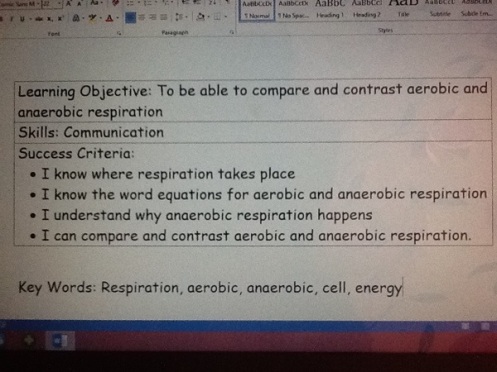
(In terms of SOLO- for more information read David Fawcett- Sharing SOLO with students or this by @Andyphilipday – this would ensure pupils had the opportunity to move their understanding on to the relational)
One could easily argue that these success criteria are more like learning outcomes. I would agree but for pupils to say yes to them (and explain them) that would constitute success. A successful lesson would be one when they feel they have achieved the success criteria. In this case they give themselves a G. If they are unsure on one or two then A and if they are really struggling an R. The only additional thing I asked pupils was that if they gave themselves less than G for learning or less than a 1 for effort they would comment on why. (the examples below are not from the respiration lesson)
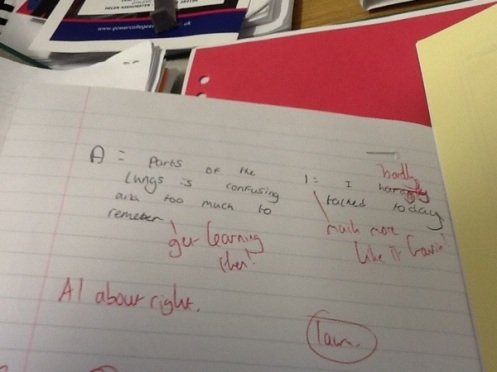
Week 1
Day 1. A decent start. The success criteria for the lesson (an introduction to health and fitness) were not too difficult. The majority of pupils gave themselves G1 and in the main I concurred. The class set took 9 minutes. The only additional comment I made was that a few pupils hadn’t clearly defined (or understood) the role of a dietician.
Day 2. This lesson included a formative assessment to be marked. Pupils gave RAG123 against the success criteria of the lesson as normal. I marked the formative assessments and using these gave my own RAG123. Instead of setting a target such as “ensure you know the difference between vital capacity and tidal volume” I wrote “use your revision notes to define vital capacity and tidal volume.” This would be the pupils’ DIRT task at the start of the next lesson. The process took about an hour which is about the same amount of time that it normally takes. It was an enjoyable hour though. I could see this would help close the gap on what they know to what I want them to know.
Day 3. Pupils had their books returned to them and acted on my comments in the DIRT time. This was so much better than just leaving a target which would be forgotten the moment it was read. I took their books in at the end of the lesson. It took me 14 minutes to RAG123 and to comment on (or just tick) their DIRT task. This was the real light bulb moment for me. I had set them a DIRT task and because I was marking books after every lesson I was able to check it. Straight away.
Day 4. Pupils checked my marking of their dirt task and looked at my RAG123. At the end of the lesson (Friday lesson 5) I couldn’t wait to get their books back in to see their RAG ratings. It took 9 minutes at the end of the day (with a coffee) to check and leave a few comments (which pupils will pick up next Tuesday). I could have left their books until Monday but I was that eager to check their work and their rating.
Week 2
No now longer a novelty (for the pupils or myself).
Tuesday. Again pupils completed a formative assessment in the lesson. This time I asked them to peer mark. Following this and by comparing performance against the lesson criteria they gave themselves a RAG123 rating. I took the books in to mark and it took me 35 minutes to look over their work and their peer marked assessment, give a RAG123 rating and set a DIRT question for the next lesson. This process could have been even quicker if I had used symbols to set the DIRT task. In general there were 4 or 5 different questions that I had set the pupils and time could have been saved by not writing the same question out over and over again.
Wednesday
Pupils checked my RAG123 and completed the dirt task.
Like last week, because I am taking the books in every lesson I could look over the DIRT task. I gave pupils their RAG123 rating (again almost always the same as theirs) and then checked their DIRT task. Again they were mostly completed correctly but I could comment further or ask for more. The marking process took 12 minutes.
Thursday
Pupils checked my RAG123 and checked my marking of their dirt task and did the extras if necessary (see picture below). The lesson didn’t quite go as I planned. The effort from many was not as it normally is. Many pupils gave themselves 2 for effort. I could comment that I agreed (or even gave a 3) and commented that things had to improve. With parents’ evening coming up the admission from a few pupils that their effort had dipped could prove very useful. I also checked on their check and/or completion of the dirt task. Pupils had homework from me that night but I took their books in and they could use their revision booklets to complete the homework. Marking took 8 minutes.
Friday
At the start of the lesson I was able to talk about the number of 2s (and a few 3s) I had awarded and how this was not acceptable. I reminded them that if I feel their efforts were only 2 over a number of lessons then there would be consequences. The effort was excellent all lesson from all pupils (all awarded themselves 1 and I concurred). I took their books in and marked their homework. Again I wanted to set a DIRT task. This time I decided that I would use symbols for the DIRT question. As I did RAG123 and marked each homework I included a symbol in their books and made a note of the question that it represented. At the end of the marking I had 6 different symbols representing 6 different dirt questions. This was more time effective than writing out the same question in books.
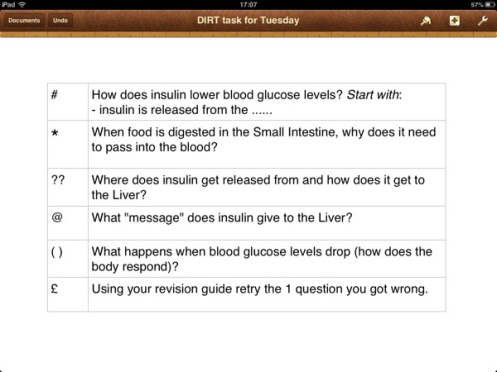
On Tuesday I will display the above and pupils will complete the DIRT task according to their symbol. Again, I can check the response when I take their books in at the end of the lesson.
After 2 weeks I feel my experiment has been a huge success. What about the pupils? I elicited some feedback:
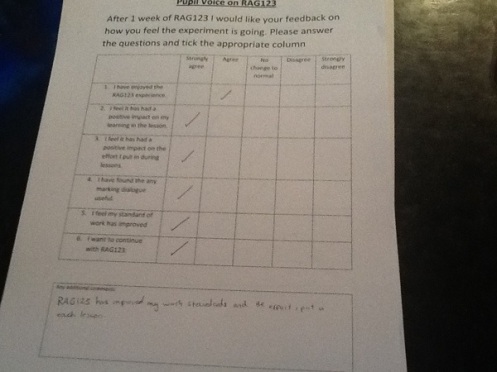
The class % for each question:
1. I have enjoyed the RAG123 experience. 95% agree (5% no change to normal)
2. I feel it has had a positive impact on my learning in the lesson. 85% agree (10% no change to normal)
3. I feel it has had a positive impact on the effort I put in during lessons. 74% agree (26% no change)
4. I have found the marking dialogue useful. 84% agree (16% no change)
5. I feel my standard of work has improved. 79% agree (21% no difference)
6. I want to continue with RAG123. 85% agree (10% not bothered either way)
Pupils have clearly valued it. One comment was “I believe that critiquing the work can help in motivating improvement. Also, it can help in motivating continuous improvement.”
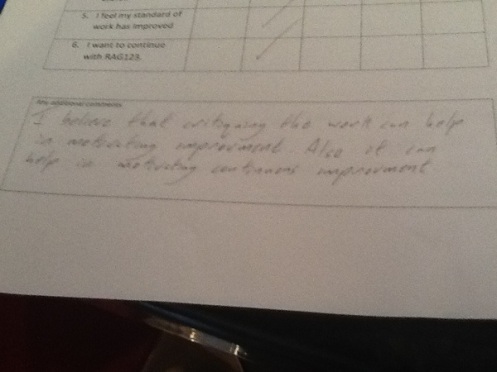
After 2 weeks of RAG123 I cannot see any reason to stop.
In my opinion the downsides (or limiting factors) for this type of day in- day out marking are:
It is hard to get started because it seems like it won’t work (but it does).
You need your own room if you take this type of marking on for a number of classes. I don’t have my own classroom and so have to transport books to my office every day (no big deal of course).
If you have family commitments and need to leave school fairly early you will struggle to do this type of marking for multiple classes because lugging books home from 5 classes isn’t really feasible.
Success criteria are needed for every lesson unless it is a subject like Maths where pupils would always have feedback on their performance (although in my opinion all lessons should have some form of success criteria so pupils know what they have-or should have been- learning and how successful they have been).
Pupils don’t take their books home (although there are ways around this).
In short, there are reasons not to try RAG123 but all can be overcome.
However, the positives absolutely smash anynegatives out of the park:
The RAG123 is simple to understand.
You may spend more time marking but it just doesn’t seem like it. You can snatch ten minutes here and there. In week 1I had spent more time marking (added up) than i would normally have. However it is so efficient that it doesn’t seem that way at all.
If you stay on after school for 5-10 minutes for each class you will never have to take marking home. No Sunday evenings ruined with hours of marking to do.
I know my class so much better than before. I know who I need to push and who may need a little bit more assistance.
Pupils value it. They really do.
You can build dialogue with the pupils. And it takes seconds:
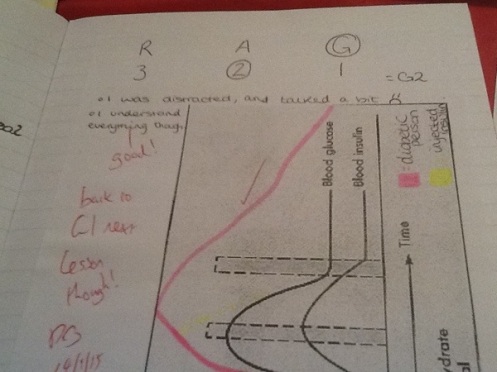 Short comments can be added as and when:
Short comments can be added as and when:
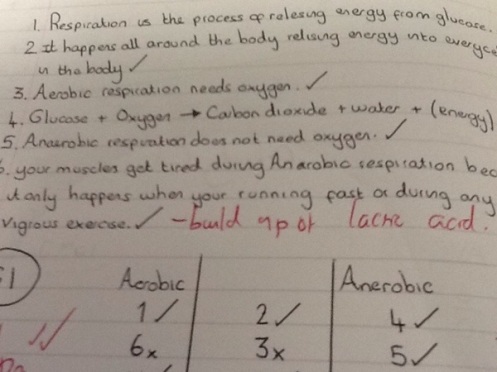 You get feedback on your lessons:
You get feedback on your lessons:
 Future lessons can be tweaked (and this is a key point).
Future lessons can be tweaked (and this is a key point).
Misconceptions can be spotted and dealt with at the source:
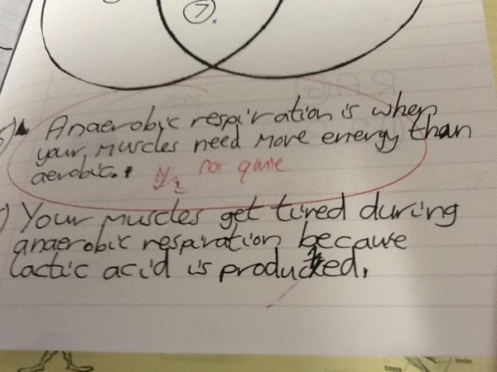 When combined with regular DIRT tasks then marking genuinely becomes a perfect combination of monitoring and closing the gap. And as I’ve mentioned, the DIRT task that they complete can be checked at the end of the lesson. Pupils get feedback on whether they have closed the gap (and what they perhaps still need to do/include).
When combined with regular DIRT tasks then marking genuinely becomes a perfect combination of monitoring and closing the gap. And as I’ve mentioned, the DIRT task that they complete can be checked at the end of the lesson. Pupils get feedback on whether they have closed the gap (and what they perhaps still need to do/include).
This should mean that the standard of work and the quality of learning improves. Which is the whole point.
It is an awesome feeling knowing that you are up to date with the marking.
The future.
I can’t ever imagine not using this type of marking for my KS4 class. I want to extend this to my Year 9 group.
I gave brief feedback in a departmental meeting last Monday. My HOD (and the department) were very interested. My HOD felt that any marking strategy which can improve the motivation of pupils (and staff) must be a good thing. It is possible that Departmental marking policy will be tweaked next year with a view to using RAG123 for our KS4 classes. A lot may depend on the exam outcomes of my group. For the rest of the year I want to continue to combine RAG123 with DIRT tasks (using symbols) for as many lessons as possible.
If you’re in doubt, try it with 1 class for two weeks (or a month depending on the number of lessons). You won’t regret it. And you won’t want to go back.
This will be the Penyrheol “tip of the week” on Monday. I wonder who will be converted?
Trackbacks & Pingbacks
- What if you marked every book, every lesson? Reinventing the feedback wheel | Improving Teaching
- The #5MinResearchPlan on #RAG123 marking | mrbenney
- “New adventures” in SOLO, flipped learning and better learning intentions. | mrbenney
- QuickKey, multiple choice and hinge questions. | mrbenney
- The Marking Experiment | scalby teaching and learning
- The FabulousFortnightly Fifteen Minute Forum- numbers 3 & 4 | mrbenney
- Marking and Feedback | Meols Cop High School
- Reflecting on teaching in 2013-14 (the routine) – what went well, what needs to be improved? | mrbenney
- Effective Group Work | educatingmiss
- Effective Group Work by @EducatingMiss | UKEdChat.com - Supporting the #UKEdChat Education Community
- Marking and Manageability (and why aren’t more people trying RAG123?) | mrbenney
- What happens to work that the teacher doesn’t mark? | mrbenney
- Easter Marking | Please Check Your Capitals
- RAG123 | MathsZest
- Strategies to improve my teaching – Site Title
- (Trying to apply) Spacing in Science | mrbenney

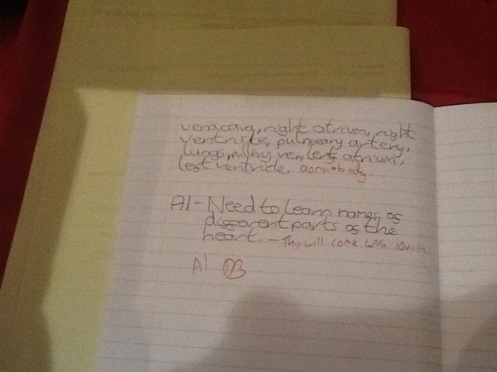
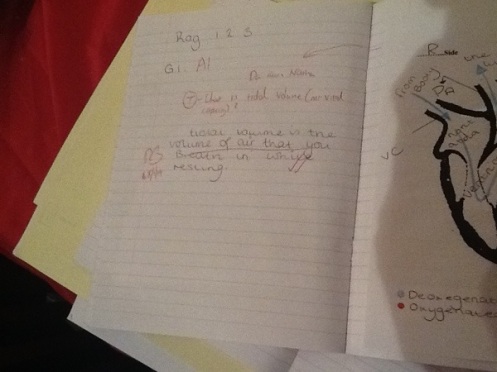
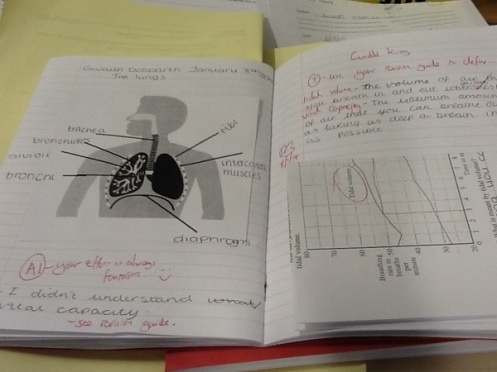
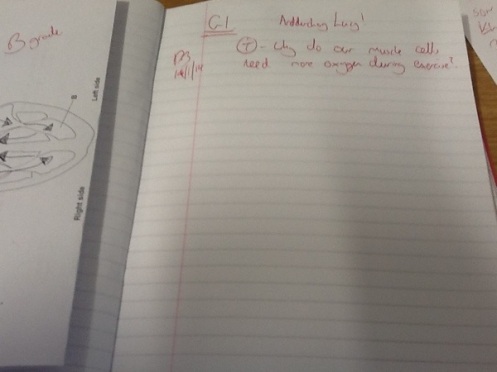
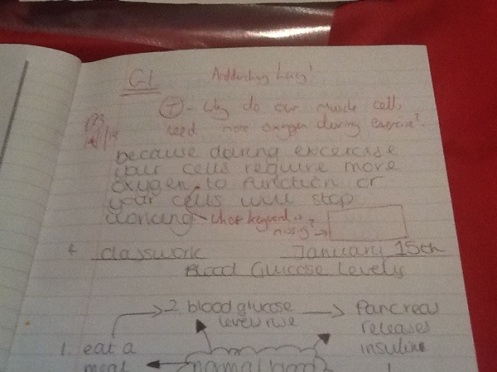
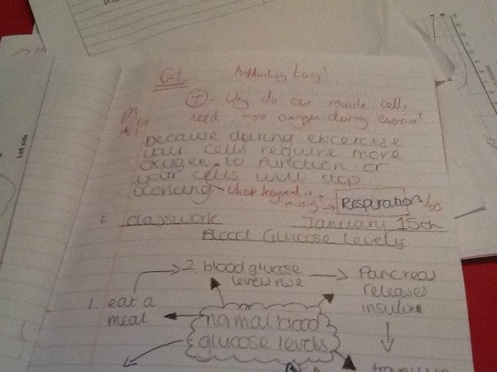
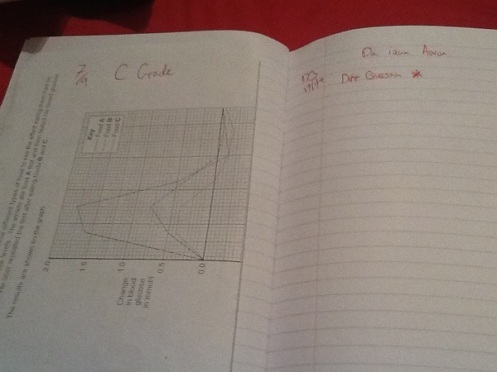
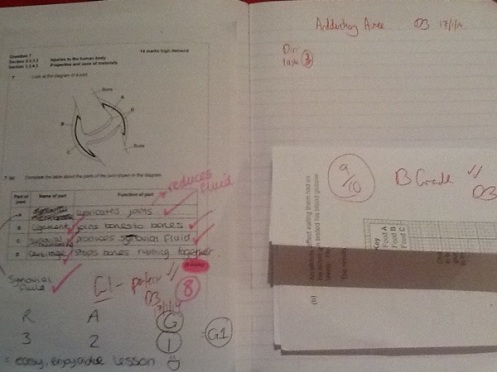
It’s a fascinating insight you’ve provided, so thank you.
A couple of questions:
1) How many students were in the trial set?
2) You’ve mentioned extending it to Y9. Do you think it would be viable lower down the school?
Hi Michael,
Thanks for taking the time to read and respond. There are 23 pupils in my group.
As for extending it lower school I think the pupils may need a bit of “coaching” to self assess against the success criteria but I think it would still be as successful (when they get the hang of it). I will try it with my Year 9s and will include the results in a follow up blog in around a months time. Again, thanks for taking the time to comment.
Damian
Thanks for that response, Damian. I ask as a middle school teacher who has tried to use approaches with Y7, with mixed success, and very aware that even further down the challenges are greater. Great to see detail on how it can work in practice… just makes me wonder whether it could be adapted for younger students…?
I think @ListerKev does RAG123 with younger pupils. He could give feedback on how Year 7 find it. Thanks again for the comment. Please let us all know if you try it.
Damian
This is about 3 posts in 1! Fantastic to read what you’re implementing in terms of marking – it looks like a big challenge. Thanks for sharing as many people will be interested in this.
Stephen
Thank you so much for taking the time to read and respond Stephen much appreciated
Damian
Really enjoyed this piece, it was a real journey of discovery and I could feel the way you developed your marking practice. I too have never really enjoyed marking but this year really driven myself to mark for feedback and give the students what they need, rather than what my time allows. I think I will blog a few thoughts too but in essence as I am down to teach just KS3 this year, I have decided to use Emotion type icons and I have to say the students really like them and respond well.
Best wishes Andy
Thanks Andy. I look forward to reading your next blog. Thanks for reading and responding
Damian
Awesome post – great explanation of your journey with RAG123 and so many hints and tips along the way.
For ref I use RAG123 across all years from 7 to 11 – similar impact across all, in fact I think my year 9 have been the most thoroughly engaged by it. Others in my dept are also using it across year groups with similar impact.
Flattered by the number of mentions you gave me but so pleased it’s been useful for you.
Looking forward to the next step on your RAG123 journey!
Keep it up – Kev 🙂
Thanks Kev. You get so many mentions because it was your idea and it is crucial that it is fully acknowledged. Glad you like the post. The experiment (and the blog) have been hugely enjoyable. Thanks again for the brilliant idea.
Damian
This looks great… I love the point where you try something and, as you say, can never imagine not doing it again. I’ve been experimenting with these ideas, influenced by the same people as you, and have likewise found that I have a clean conscience and students are doing better as a result.
Also good to see you habituating yourself to blogging – and lovely to see so much student work – which I think makes posts very useful and ideas easier to grasp.
Thanks for taking the time to comment. Including lots of examples of pupil work was something I got from many blogs and yours in particular. It makes it very real. Thanks again Harry.
Damian
What a fantastic blog post! I thought it’s great strength was the way you took us through the process from your initial “confessions” (brilliant) then lesson-by-lesson right through the process to the evaluation stage (massively important – people want to know it works!) The use of SV was also excellent. You showed the whole process to be a ‘no brainer’, i.e. it’s quicker and easier for you, you pick up on their misconceptions quicker, feeds into your planning lesson by lesson and they like it!
I would imagine the next stage/blog is to evaluate the impact on outcomes. Maybe have a control group that doesn’t get RAG123 marking?
Keep blogging!
Thanks Dan. Your support and encouragement is hugely appreciated. There will definitely be a follow up blog and I will take on board some of your ideas for comparison. It has quickly become an embedded routine and as you said, a no-brainer. After RAG123 ing books yesterday it was clear that a little more consolidation was needed on moments with the elbow as a pivot. This would not have been picked up without every book every day marking. Thanks again Dan,
Damian
Great idea that my Year 11 maths class have really embraced. Using symbols makes setting individual follow up tasks quick, easy and actually increased the learning chat in their pairs. My next step is getting them to better explain why they aren’t a smiley face (in place of RAG). Or perhaps I need to make a bigger deal of articulating/displaying the steps of mastering each maths skill? Much thinking to do…
Thanks for the feedback. It sounds like your work is paying dividends for you and your students. Getting pupils to articulate what they are struggling with is not easy but can really help in tweaking future lessons or giving specific one on one feedback. You ask an interesting question at the end. It’s great that this form of marking makes you think about the learning that is taking place (it does for me). As you said, much thinking to do….
Thanks again for taking the time to read and comment,
Damian
Thanks for this Damian. I loved the honesty in the post. It has inspired me to change the way that I mark, and as a middle school teacher I will start in the middle with year 7 and disseminate both upwards and downwards if I manage to have half the success that you have had. I am also sharing this with staff through my smore bulletin. I will, of course, acknowledge you as you have with those who inspired you.
Best of luck in the future.
My absolute pleasure. Thanks for the feedback. It has been a success for myself and the students. Have you read my new blog on trying to measure the impact of RAG123 marking?
If you do trial it please let us know how you get on.
Thanks again,
Damian
Yes, read and excited by the effect size. As a fellow science teacher it means a lot to know that the effort is backed up by evidence.
I’m science too and excited to trial with my year 7s tomorrow!!
Hi, a great reflective blog on the perennial bugbear that is marking. Do you have a Twitter name? It would be nice to share this blog wider. 🙂
Damian